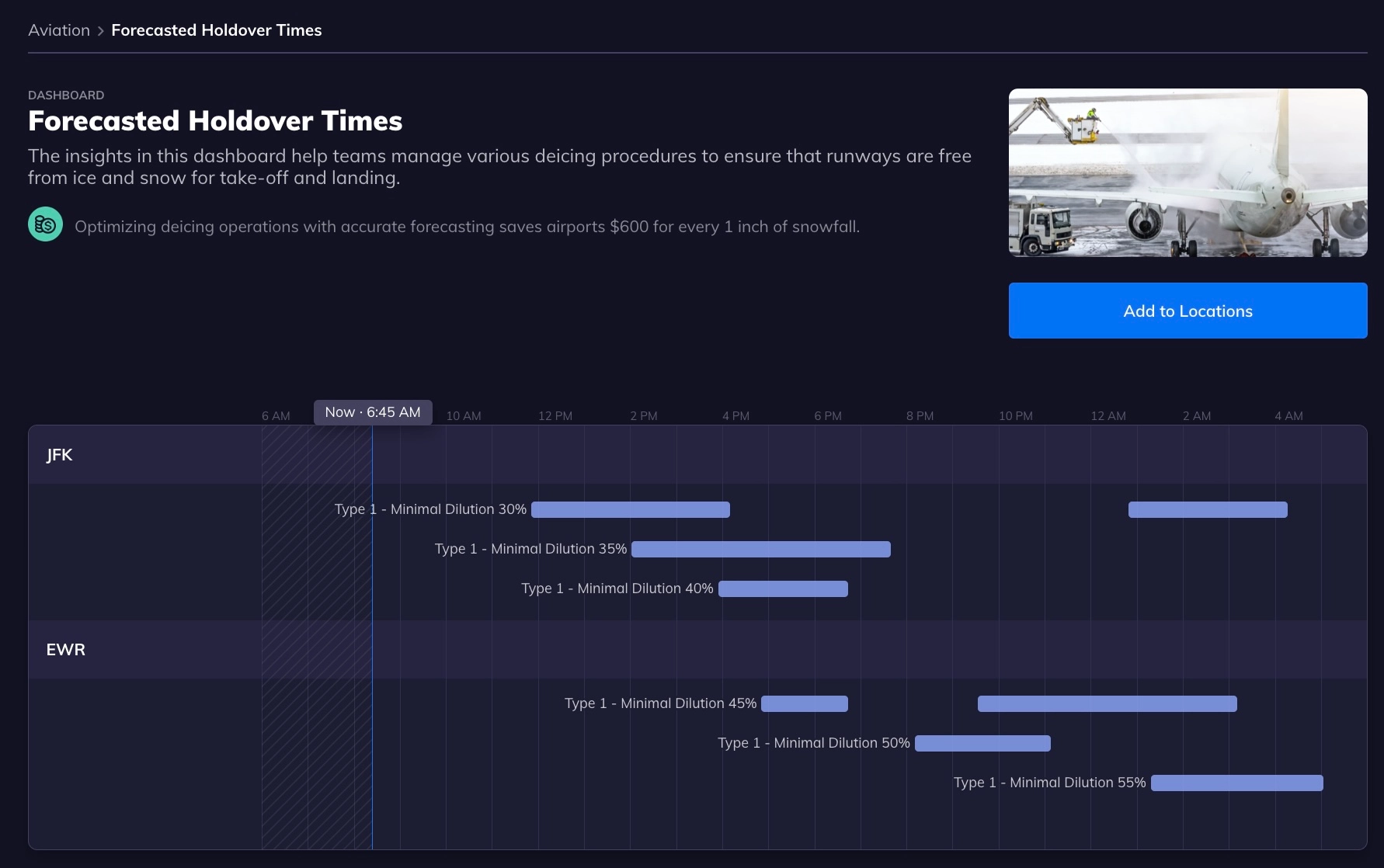TL;DR:
- Real-time weather data is revolutionizing airline deicing operations, allowing for proactive planning and efficient resource allocation.
- Advanced deicing technologies, such as automated systems, are enhancing safety and operational efficiency.
- Eco-friendly deicing practices are becoming a priority to reduce environmental impact and comply with regulations.
- Integration of real-time weather data improves decision-making, enhances safety, and reduces the risk of ice-related incidents.
- Strategic use of weather data in deicing operations leads to significant cost savings, reduced delays, and improved resource management for airlines.
In the airline industry, managing winter operations effectively is crucial, particularly when it comes to deicing. Ice on aircraft surfaces is not just a safety hazard but also affects flight schedules and increases operational costs.
Ever wonder why your plane gets deiced? Snow and ice can affect its ability to generate lift and maintain control in flight.
Our Centralized Deicing Facility is a 24/7 operation that can process up to 500 planes a day! #SafetyFirst #OnStorm pic.twitter.com/j5zljV3iip
— Toronto Pearson (@TorontoPearson) February 12, 2019
Traditionally, airlines have dealt with deicing reactively, responding to weather conditions as they happen.
However, with advancements in weather forecasting technologies, a proactive and strategic approach is now achievable.
Real-time weather data is changing the way airlines handle deicing operations. By using predictive analytics and accurate weather forecasts, airlines can predict deicing needs, optimize resource use, and significantly cut down on delays and costs. This ensures the safety and reliability of fleets during adverse weather and enhances operational efficiency and cost-effectiveness.
This integration of data solutions into airline deicing strategies not only helps maintain schedules and control expenses but also promotes a safer, more sustainable, and economically sound operational framework. This strategic edge can make airlines more competitive in the tough aviation market.
Predictive Analytics and Weather Data in Deicing Operations
The foundation of effective deicing operations in the airline industry lies in the ability to forecast the weather accurately and understand its implications. Predictive analytics, fueled by advanced weather data, allows airlines to anticipate and prepare for deicing needs before ice becomes a problem.

- Predictive Planning: By analyzing weather trends and forecasts, airlines can schedule deicing operations ahead of time. This proactive approach prevents the last-minute rush that often leads to delays and operational bottlenecks. Airlines can have crews and equipment ready precisely when and where they are needed, which optimizes the use of resources and reduces idle time for aircraft and staff.
- Efficient Resource Allocation: With real-time weather insights, airlines can allocate deicing fluids and equipment more effectively. Knowing the severity and timing of incoming weather conditions enables precise calculations of how much deicing fluid is needed, reducing waste and cost.
- Minimizing Delays and Enhancements in Safety: Accurate weather predictions enable airlines to perform deicing at optimal times, minimizing the window during which ice can affect aircraft performance. This timeliness not only reduces delays but also enhances the safety of flights. Airplanes take off with clean surfaces free from ice accumulation, ensuring aerodynamic efficiency and safety.
This strategic use of predictive analytics and real-time weather data not only makes deicing operations more efficient but also significantly cuts down on unnecessary costs associated with delays and excessive use of deicing materials.
Advanced Deicing Technologies
Innovation in deicing technologies has provided airlines with more effective tools to combat ice accumulation, enhancing both safety and operational efficiency. These technologies range from sophisticated deicing fluids to automated deicing systems that reduce human error and ensure thorough coverage.
- Current Technologies in Use: Traditional methods, such as using propylene glycol-based fluids sprayed on aircraft surfaces, are still prevalent. However, advancements have led to more efficient application methods and formulations that minimize environmental impact and reduce the amount of fluid required.
- Automated Deicing Systems: One of the significant advancements is the introduction of automated deicing systems. These systems use precise nozzles and controlled spray patterns to apply deicing fluids, ensuring optimal coverage with minimal waste. Automation also speeds up the process, allowing for quicker turnarounds and less downtime for aircraft.
Case Studies of Successful Implementation:
Several airlines have begun integrating these advanced systems into their operations with notable success.
JetBlue, for example, depends on Tomorrow.io to know when to de-ice their planes. This saves costs on de-icing fluid, keeps planes running, and prevents delays.
By adopting advanced deicing technologies, airlines can not only enhance the effectiveness of their deicing operations but also achieve significant cost savings and environmental benefits. This proactive approach to technology adoption is essential for staying competitive in the fast-evolving aviation industry.
Eco-Friendly Deicing Practices
As environmental concerns continue to rise, the airline industry is increasingly focusing on sustainable practices. This shift is particularly visible in the field of aircraft deicing, where the use of eco-friendly materials and methods is becoming a priority to reduce the environmental impact.
- Environmental Impacts of Traditional Deicing Fluids: Traditional deicing fluids, primarily composed of glycol, can be harmful to ecosystems if not properly managed. These substances can runoff into nearby waterways, posing risks to aquatic life and water quality.
- Development of Sustainable Deicing Solutions: In response to these environmental challenges, there has been a push towards developing more sustainable deicing fluids and practices. New formulations that are more biodegradable and less toxic are being tested and implemented, reducing the ecological footprint of deicing operations.
- Accurate Weather Forecasting to Minimize Chemical Use: By leveraging precise weather data, airlines can optimize the timing and quantity of deicing fluid applied. This not only conserves resources but also prevents overuse of chemicals, which is crucial for minimizing environmental impact. For example, knowing the exact onset of a freezing event allows airlines to schedule deicing operations closer to departure times, which can significantly reduce the amount of fluid needed.
- Regulatory Changes and Industry Compliance: As regulations around environmental protection tighten, airlines are compelled to adopt these eco-friendly practices not just for sustainability but also for compliance. Innovations in deicing technology that align with environmental standards are therefore not only good for the planet but also essential for regulatory approval.
The move towards eco-friendly deicing practices reflects a broader commitment by the airline industry to sustainability. By adopting these practices, airlines not only comply with environmental regulations but also enhance their brand reputation among increasingly environmentally-conscious consumers.
Real-Time Weather Data and Safety Enhancements
The integration of real-time weather data into airline operations is a game-changer, particularly in terms of enhancing safety and reducing the risk of ice-related incidents. This data-driven approach to deicing ensures that airlines can respond swiftly and effectively to changing weather conditions.
- Importance of Real-Time Data: Real-time weather data provides airlines with up-to-the-minute information on conditions that could affect ice formation on aircraft. This immediacy allows for more responsive and precise deicing actions, ensuring that no aircraft leaves the ground with ice buildup that could impede its performance.
- Enhanced Decision-Making: With access to real-time data, airline operation centers can make informed decisions about when to deice, how much fluid to use, and what methods to employ. This not only improves the efficiency of the process but also significantly enhances safety by reducing the likelihood of ice-related performance issues.
- Technological Advancements in Anti-Icing Systems: Modern anti-icing systems, which prevent ice from forming on aircraft surfaces, have also benefited from advancements in real-time data integration. These systems can be automatically adjusted based on real-time weather conditions, optimizing their effectiveness and reducing the need for chemical deicing fluids.
- Safety Improvements with Weather Data: The ultimate benefit of integrating real-time weather data into deicing operations is an improvement in overall flight safety. Timely and effective deicing reduces the risk of accidents caused by ice accumulation, thereby protecting passengers, crew, and aircraft alike.
The strategic use of real-time weather data not only streamlines deicing operations but also builds a stronger safety culture within airlines. This proactive approach to safety management is crucial for maintaining trust and reliability among passengers and airline stakeholders.
Financial Implications and Cost Management
The strategic use of weather data in deicing operations has significant financial implications for airlines. By optimizing deicing processes, airlines can achieve substantial cost savings, which directly enhance their bottom lines.
- Reduced Delays and Cancellations: Delays and cancellations are among the most costly issues airlines face. Efficient deicing, enabled by accurate weather forecasting, reduces these incidents by ensuring that aircraft are ready to depart on schedule. This reliability saves on compensation costs, reduces the need for rebooking passengers, and minimizes disruptions to the airline’s operations.
- Optimized Use of Deicing Fluids: Deicing fluids are expensive, and their application must be carefully managed to control costs. Real-time weather data helps airlines use these fluids more efficiently by providing precise information on when and where deicing is necessary. This prevents wastage and ensures that fluids are only used when absolutely needed, leading to significant cost reductions.
- Efficient Staffing and Resource Allocation: Knowing when deicing will be required allows airlines to schedule staff and resources more effectively. This not only cuts down on labor costs by preventing overstaffing during periods of low demand but also ensures that resources are available when most needed, thereby increasing operational efficiency.
- Maintenance and Longevity of Aircraft: Regular exposure to deicing chemicals can accelerate the wear and tear on aircraft parts. By using weather data to reduce unnecessary deicing, airlines can prolong the lifespan of their aircraft and decrease the frequency and cost of maintenance. This strategic approach not only saves money but also keeps aircraft in better condition for longer periods.
- Fuel Savings: Aircraft waiting for deicing may need to idle longer, consuming more fuel. Efficient scheduling and quick deicing processes, guided by real-time data, minimize this idling time, leading to direct fuel savings.
“This micro-forecast is already saving $300,000 every month, $3.7 million in a year.” – JetBlue
These cost-saving measures demonstrate how the effective use of weather data in deicing operations not only enhances safety and reliability but also provides financial benefits. By reducing operational costs and improving efficiency, airlines can reinvest these savings into further innovations or pass the benefits on to passengers through competitive pricing.
Tomorrow.io Supports Operational Resilience
The integration of real-time weather data into airline deicing operations marks a transformative shift in addressing winter weather challenges. Adopting predictive analytics and advanced technologies allows airlines bolster safety, operational efficiency, and environmental sustainability, translating directly into cost savings, reduced delays, and improved resource management. This proactive approach meets current demands and positions airlines for future success amid stricter regulations and heightened passenger expectations.
Moving forward, the industry’s focus on innovative technologies and comprehensive data solutions will be paramount for continued success in adverse weather conditions.





